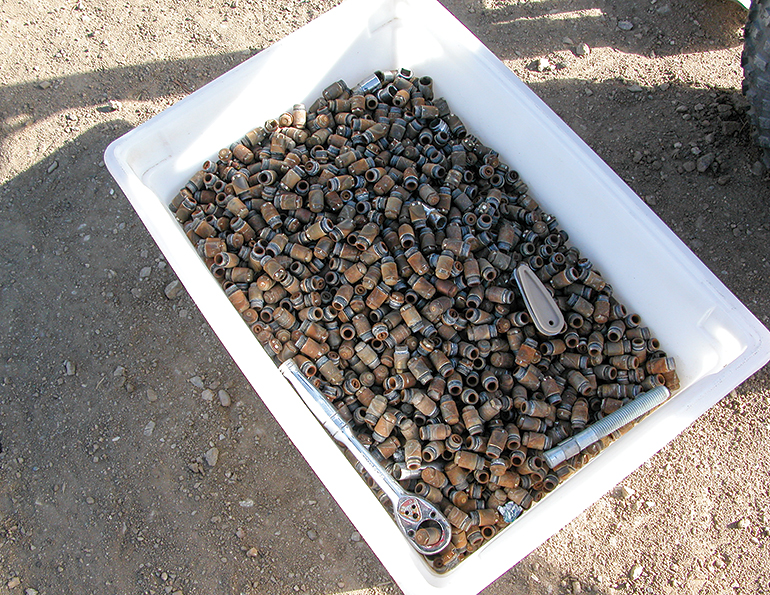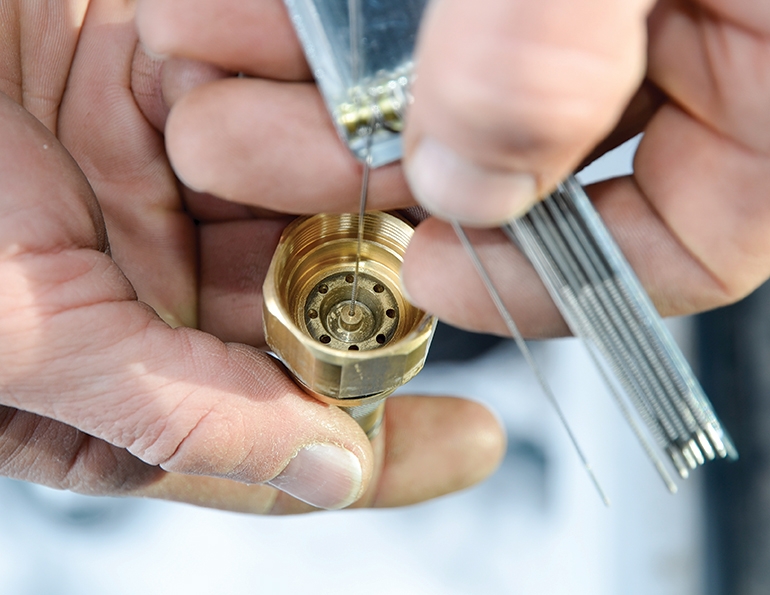SAM last broached snowmaking maintenance in September 2016 in the aptly-named article, “Snowmaking Maintenance.” It’s still relevant and a great pre-season checklist, but snowmaking systems and equipment have evolved since then. “Snowmaking maintenance has grown since the days you could shoot a mouse through a Snow Giant II and keep right on making snow,” says Steve Crowley, VP of operations for Holiday Valley, N.Y.
The core of good snowmaking maintenance is still centered on pumps and compressors, the pipe network, hoses, and deploying and retrieving guns. But “maintenance has grown,” Crowley perhaps understates. Many factors drive this growth—namely the continued shift to automation.
There is now a lot more automated snowmaking on our mountains, in respect to both guns and systems. Holiday Valley’s system, for example, was 100 percent manual a decade ago. Today, it is more than 50 percent automated with 352 automatic stick guns.
Resorts that have moved to automation show tremendous gains in efficiency and performance. Since moving to automation, Holiday Valley increased its water converted to snow by 123 percent to 240 million gallons. At the same time, it cut the hours required to do it by 45 percent, and the resort lowered its cost per acre foot by 65 percent. This level of performance demands well-orchestrated preventive, off-season maintenance.
The goal of maintenance should be that any system can be at 100 percent performance whenever management says, “snow time.” So, the maintenance plan needs to be completed before the projected season startup date. Let’s cover a few items to include in your plan.
HYDRANTS AND SHELTERS
Full automation usually requires an automated hydrant below grade in a shelter or pit. Shelter and automatic valve maintenance are the core of the maintenance programs at resorts with a long history and high percentage of full automation.
Oftentimes, many problems with automatic hydrants are attributed to “moisture.” This tends to be a euphemism for, “the shelter is flooded, and the valve or actuator and electronics are underwater.” These issues stem from poor construction of the shelter and a lack of adequate drainage.
Good documentation from the snowmaking controller helps resorts identify problematic shelters. Once identified, maintenance options are to relocate or to retrofit fail-safe drainage for the shelter, which can sometimes mean digging a drain to daylight. This is best accomplished with nonperforated drain tile and may require shelters to be linked together to find daylight.
For shelters known to have drainage issues, some resorts will just strip the vulnerable equipment (valve or actuator, electronics, etc.) when snowmaking ends rather than waiting for the season’s end.
Sun Valley, Idaho, which has 650 fully automatic shelters, Craigleith, Ont. (602), Holiday Valley (352), and Mt. St. Louis Moonstone, Ont. (265), all use their computer data to identify shelter faults and rebuild them in the off season. In addition, they also clean and rebuild 20 percent of the oldest automatic valves and actuators every summer for regular preventative maintenance.
Fully operational. For Craigleith GM Jeff Courtemanche, the goal is zero in-season failures among his auto arsenal. Dennis Harper, maestro of one of the oldest and biggest automatic systems in North America, Sun Valley, likes to start his season with “no red dots,” meaning 100 percent operational, with no faults.
COMM LINES AND CRITTERS
The other natural enemies of automated systems are rodents and tracked excavators. Many operators will disconnect the electronic components of their automated systems in the off-season as a safeguard against lightning strikes. Sun Valley, on the other hand, leaves its communications system hot. This way, Harper can learn about problems—like rodents and excavators—as they happen, and address them during the summer.
Rodents find exposed low-voltage communication wire somehow appealing. This can be mitigated or corrected by doing professional-grade installations with comm wire in conduit at every opportunity—whether during initial installation, or as an upgrade.
In the summer, excavators are often onsite for other projects. Before a bucket enters the ground, the operator should know if anything is underneath the surface—wires, pipe, or other utilities—in order to avoid catastrophe. Implementing a strict “locate before dig” policy across all departments and utilities is the best defense against this type of damage.
COMPUTER CLEANING
Almost every snowmaking system uses computers in a tough physical environment. They may become choked with dust and dirt. Cleaning your computer and backing up your data at the end of the season—or more often—is recommended. Yes, computers and software are now part of snowmaking maintenance.
SNOW GUN CHECKLIST
Snow guns have gained tremendous efficiency in recent years. To get there, most guns use multiple, smaller diameter spray nozzles and sophisticated nucleation that, along with the automated valves and hydrants, don’t tolerate dirty or heavy-mineral ladened, abrasive water.
Mt. St. Louis Moonstone’s gun check process for the end of the snowmaking season, detailed in its in-house manual, provides a clear breakdown of key gun-maintenance steps:
1. Conduct an operational test of every automated gun at the end of the snowmaking season. Look at the pit prior to starting each gun to check for issues at pressure, but not while running. Start the device through all stages to note any issues, looking for spray pattern, oscillation, elevation, etc. Document observations and determine whether to pull for maintenance or to “service in place.”
2. In addition to the failure pull list, pull 20 percent of existing below-ground valves for regular preventative maintenance (every hydrant every five years), except for failures pulled and fixed in the last 1-2 years.
3. After the test, decommission guns for the season, disconnect communication lines, remove power, turn off breakers, and pull fuses.
4. Pull all nozzles and nucleators by vintage, i.e., age of install, to maintain wear consistency. Bring them off hill to be cleaned by an “ultrasonic” cleaner.
5. Once all pulls are out for maintenance, service remaining guns in place. This includes regular maintenance plus “service in place” fixes noted in step one.
 Nozzles pulled for ultrasonic cleaning.
Nozzles pulled for ultrasonic cleaning.
6. Return nozzles as completed.
7. Bag all tower and mobile fans.
The masters of maintenance all have detailed, written maintenance plans, like Mt. St. Louis Moonstone’s. Much of the same treatment applies to semi-auto or manual guns that have nucleators or small spray nozzles.
Parts cleaning. Many resorts and suppliers give rave reviews to “ultrasonic” parts cleaners using CLR cleaning solution at 120 degrees. The crew at Mt. St. Louis Moonstone says their ultrasonic cleaner paid for itself three-fold in the first season.
Another technological tool that supports maintenance: an infrared heat detecting gun. Craigleith uses one to check the function of heating cartridges in the guns and hydrants. It also uses the technology on electric equipment and terminations, as well as bearings.
 L to R: Shelter with retrofitted drain to daylight; Automatic valves pulled at Craigleith; Cleaned and uncleaned fan nozzles.
L to R: Shelter with retrofitted drain to daylight; Automatic valves pulled at Craigleith; Cleaned and uncleaned fan nozzles.
DISTRIBUTION SYSTEMS
Many North American resorts have aging distribution systems that can be prone to losing air and water pressure. This is a maintenance nightmare.
Leak Finding. For example, one large resort, to remain unnamed, loses 6,000 cfm of compressed air to leaks before it can think about building pressure. This is not one easy-to-find major leak, either. Instead, it’s “death by a thousand cuts.”
Craigleith pressurizes both air and water lines with air, which can make the small leaks easier to find as personnel walk each line in the fall using stethoscopes to pinpoint where to dig.
Because walking the whole system seems impractical at Sun Valley, the crew borrows geophones from the local water department to find small water leaks. A geophone is an acoustic detector that responds to ground vibrations generated by seismic waves.
Harper explains: “With a pressure gauge at the low point and the water turned off, let the leak drop the pressure to where the leak is. Then, find the elevation with a feet of head calculation. Go to the elevation with GPS and mark it. Turn the water to the line back on, go to your mark, and use geophones to pinpoint your leak.”
Pump and compressor inefficiencies impact the distribution system. A savvy controller with good historical documentation can identify problems with pumps and compressors before failure.
Many resorts outsource testing and service of pumps and compressors every season or two. Some resorts are stretching that interval because new efficiency means the equipment runs for less hours. Sitting idle can have detrimental effects, though, with components not seeing oil, flat spotting bearings, etc.
To avoid these issues, many resorts turn the equipment over by hand or, if the demand structure allows, spin them a bit every month.
When the tech shows up to service the equipment, make sure he or she calibrates the digital sensors, including air and water flow meters, as part of the visit. This step can often be neglected.
Hoses should not be forgotten, either. Even small hose issues suck up time that operations cannot spare. If you roll hoses, you have the opportunity to visually check them.
Most fully-auto guns do not use rolled hose, but those hoses can still deteriorate over time. Some resorts pressure-test all hoses older than 5 years to ensure they’re in good working condition.
DON’T FORGET YOUR CREW
High-tech equipment takes a different skill set to operate and maintain. For example, a resort that moved from all fixed-grip lifts to largely detachables found it needed an expanded crew with more electronic and mechanical skills. The same applies to servicing automated snowmaking equipment.
Training and experience will help develop the necessary skills. To that end, resorts benefit from access to suppliers’ highly skilled techs and training workshops. Supplier manuals are also an excellent but underutilized resource. Harper of Sun Valley says his best maintenance trick is to “do the work!” After being properly trained, of course.
Every automated system needs a champion, or championship team. The mentality of “if it ain’t broke, don’t fix it,” is pretty much gone from snowmaking. Everyone should take great pride in what their snowmaking team and system can accomplish—our winter depends on it.






